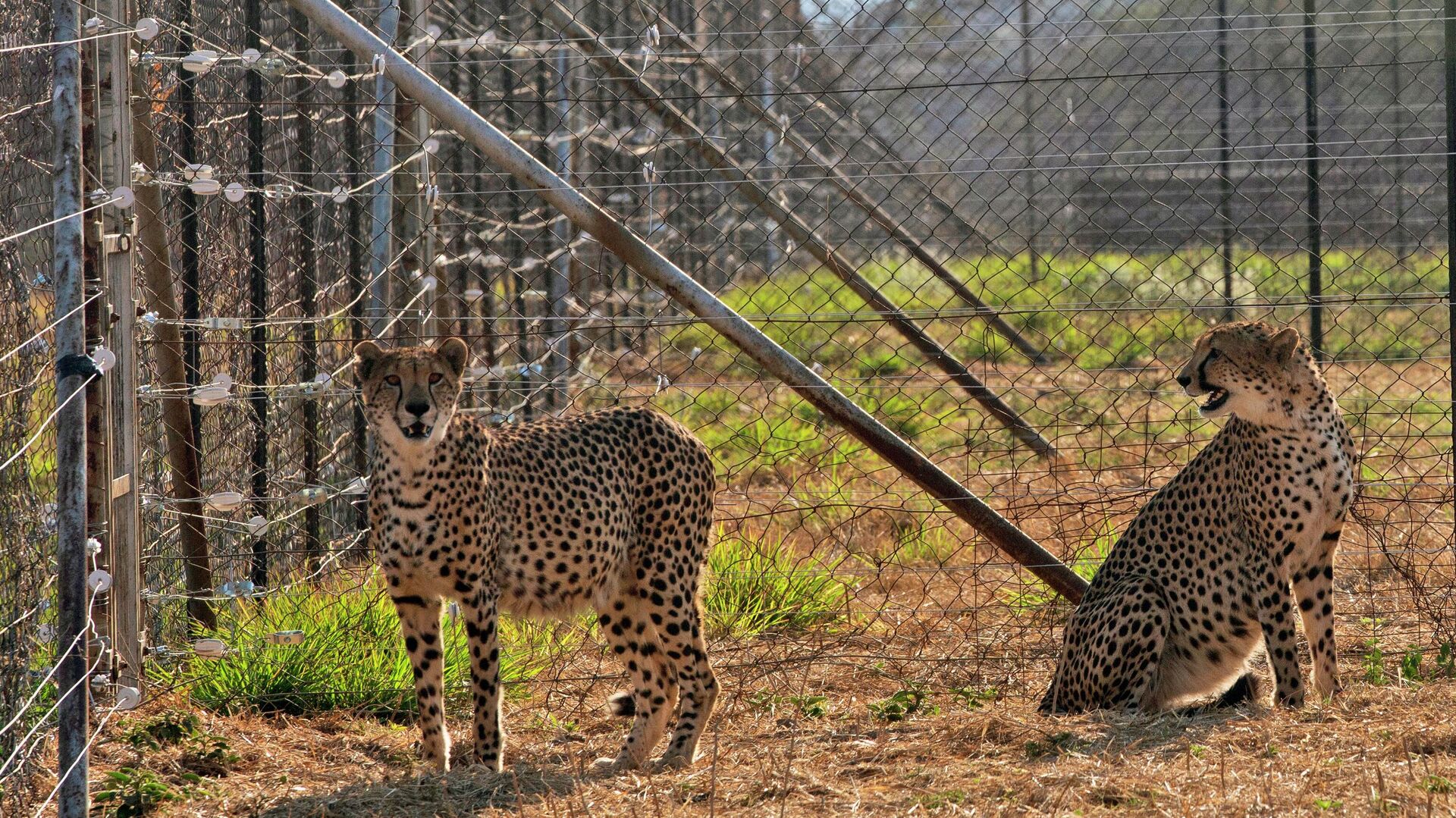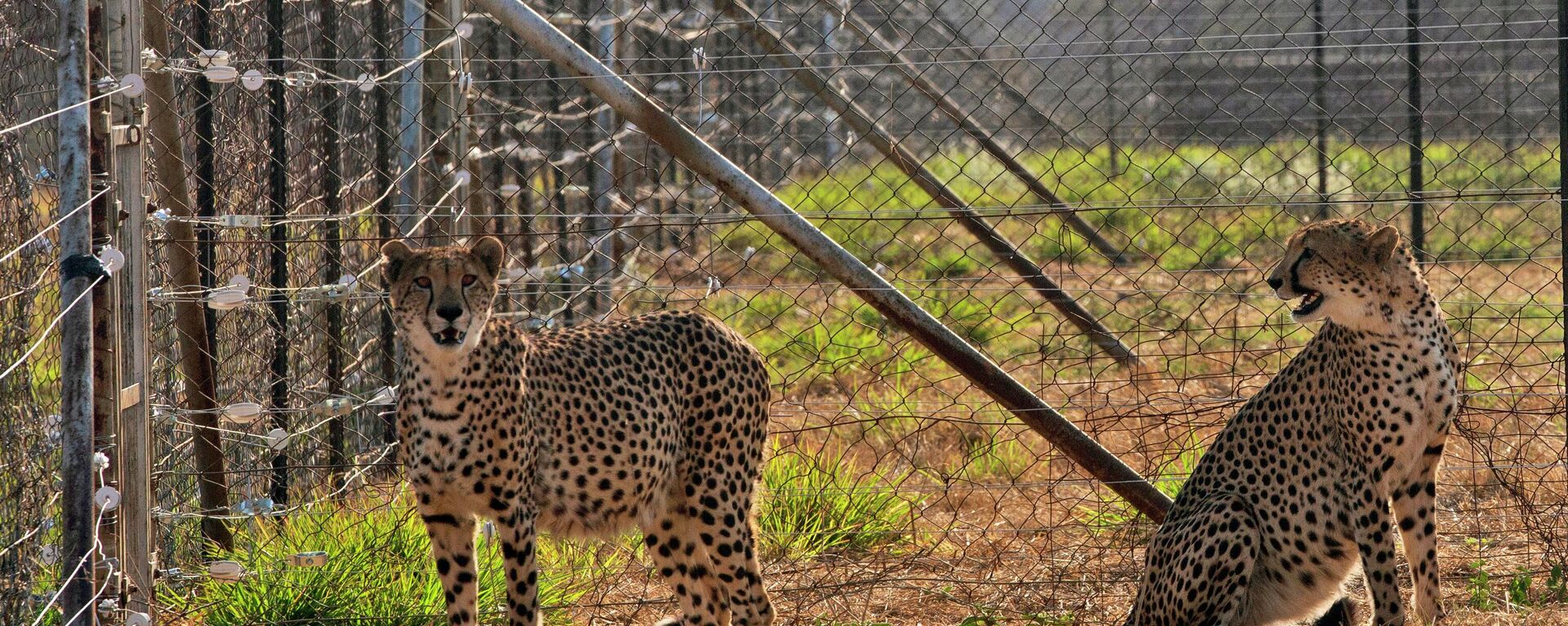https://sputniknews.in/20230919/gandhi-sagar-nauradehi-wildlife-sanctuaries-get-ready-for-next-batch-of-cheetahs-4315930.html
Gandhi Sagar, Nauradehi Wildlife Sanctuaries Get Ready For Next Batch of Cheetahs
Gandhi Sagar, Nauradehi Wildlife Sanctuaries Get Ready For Next Batch of Cheetahs
Sputnik India
Under India's 'Cheetah Project' launched last year, 20 big cats from South Africa and Namibia were translocated to Kuno National Park in Madhya Pradesh state. However, the project hit a low after the death of nine cheetahs, including three cubs.
2023-09-19T11:19+0530
2023-09-19T11:19+0530
2023-09-19T11:19+0530
india
science & tech
kenya
africa
bharatiya janata party (bjp)
african cheetah
south africa
namibia
wildlife
nature conservation
https://cdn1.img.sputniknews.in/img/07e7/08/04/3405987_0:207:3072:1934_1920x0_80_0_0_074d47aff00c271950fb63ae9440501a.jpg
The Gandhi Sagar Wildlife Sanctuary and Nauradehi Wildlife Sanctuary in India's Madhya Pradesh state are soon going to be the new home of a second batch of cheetahs that will be relocated from South Africa.Cheetah Project head SP Yadav told an Indian news agency that wildlife officials are preparing the two sites and that work is in full swing at the Gandhi Sagar Wildlife Sanctuary, which is expected to be ready by December. Cheetah Steering Committee head Dr. Rajesh Gopal, who was at the Gandhi Sagar Wildlife Sanctuary, told Indian media that although the area looks very promising and similar to Masai Mara in Kenya with open glades, a rocky area, and shallow soil, there is still a lot of work to be done.Officials have started building a prey-revival area, but it is yet to get prey and will take time. To prevent the deaths of the cheetahs, the steering committee has made some suggestions.One of them proposes that cheetahs with thinner coats from the northern hemisphere should be introduced instead of the previous ones, which had “thicker winter coats,” as they did not suit the humid weather conditions during monsoons in India.Cheetahs from the northern hemisphere are said to be more suitable for the Indian climate, Dr Gopal said, adding that a dry climate is ideal for cheetahs as it supports gregarious groups of fast-running animals.Dr Gopal also added that experts are also working on introducing state-of-the-art lightweight radio collars.
https://sputniknews.in/20230805/why-are-kunos-cheetahs-dying-3365344.html
india
kenya
africa
south africa
namibia
Sputnik India
feedback.hindi@sputniknews.com
+74956456601
MIA „Rossiya Segodnya“
2023
Sangeeta Yadav
https://cdn1.img.sputniknews.in/img/07e6/0c/0f/110602_0:0:641:640_100x100_80_0_0_c298016a79eb02ef8caa9d1f688c12a5.jpg
Sangeeta Yadav
https://cdn1.img.sputniknews.in/img/07e6/0c/0f/110602_0:0:641:640_100x100_80_0_0_c298016a79eb02ef8caa9d1f688c12a5.jpg
News
en_IN
Sputnik India
feedback.hindi@sputniknews.com
+74956456601
MIA „Rossiya Segodnya“
Sputnik India
feedback.hindi@sputniknews.com
+74956456601
MIA „Rossiya Segodnya“
Sangeeta Yadav
https://cdn1.img.sputniknews.in/img/07e6/0c/0f/110602_0:0:641:640_100x100_80_0_0_c298016a79eb02ef8caa9d1f688c12a5.jpg
nauradehi wildlife sanctuary, gandhi sagar wildlife sanctuary, cheetahs, prime minister narendra modi, namibian cheetahs, kuno national park, knp, madhya pradesh, cheetah released into the wild, succumbed to a kidney-related ailment, heart failure, died due to a fight, world’s fastest land animal, african cheetahs, namibian, south africa, poaching, human-wildlife conflict, cheetah conservation, revival of cheetah in india, pradnya giradkar, india's cheetah lady, expert in cheetah conservation, cheetahs translocated, new place, introduced into a new environment, high mortality rate, vulnerable species, international union for conservation of nature, iucn, mortality rates are high, first indian to be trained by the cheetah conservation fund (ccf), global institution to save the big cats, dr. laurie marker, a renowned wildlife researcher, asian cheetahs and african cheetahs, newborn cubs' mortality rate, cheetah population in india, study tour to namibia south africa, india's forest minister bhupender yadav, cheetah revival plan, namibia, preserve wildlife endangered species, biodiversity, ecotourism industry, kuno national park in madhya pradesh, what is india’s project cheetah all about?, asiatic cheetah, neolithic age, sanskrit word ‘chitraka’, cave paintings, world's fastest animal, gazelle, blackbucks, mughal emperor akbar, jahangir, british rule, rapid decrease in the cheetah population in india, maharaja ramanuj pratap singh deo, royal family of koriya from chhattisgarh,
nauradehi wildlife sanctuary, gandhi sagar wildlife sanctuary, cheetahs, prime minister narendra modi, namibian cheetahs, kuno national park, knp, madhya pradesh, cheetah released into the wild, succumbed to a kidney-related ailment, heart failure, died due to a fight, world’s fastest land animal, african cheetahs, namibian, south africa, poaching, human-wildlife conflict, cheetah conservation, revival of cheetah in india, pradnya giradkar, india's cheetah lady, expert in cheetah conservation, cheetahs translocated, new place, introduced into a new environment, high mortality rate, vulnerable species, international union for conservation of nature, iucn, mortality rates are high, first indian to be trained by the cheetah conservation fund (ccf), global institution to save the big cats, dr. laurie marker, a renowned wildlife researcher, asian cheetahs and african cheetahs, newborn cubs' mortality rate, cheetah population in india, study tour to namibia south africa, india's forest minister bhupender yadav, cheetah revival plan, namibia, preserve wildlife endangered species, biodiversity, ecotourism industry, kuno national park in madhya pradesh, what is india’s project cheetah all about?, asiatic cheetah, neolithic age, sanskrit word ‘chitraka’, cave paintings, world's fastest animal, gazelle, blackbucks, mughal emperor akbar, jahangir, british rule, rapid decrease in the cheetah population in india, maharaja ramanuj pratap singh deo, royal family of koriya from chhattisgarh,
Gandhi Sagar, Nauradehi Wildlife Sanctuaries Get Ready For Next Batch of Cheetahs
Under India's “Cheetah Project” launched last year, 20 big cats from South Africa and Namibia were transferred to Kuno National Park in Madhya Pradesh state. However, the project hit a low after the death of nine cheetahs, including three cubs.
The Gandhi Sagar Wildlife Sanctuary and Nauradehi Wildlife Sanctuary in India's Madhya Pradesh state are soon going to be the new home of a second batch of cheetahs that will be relocated from South Africa.
Cheetah Project head SP Yadav told an Indian news agency that wildlife officials are preparing the two sites and that work is in full swing at the Gandhi Sagar Wildlife Sanctuary, which is expected to be ready by December.
South African President Cyril Ramaphosa, during the 15th BRICS Summit last month in Johannesburg, South Africa, promised to donate more cheetahs to India.
Cheetah Steering Committee head Dr. Rajesh Gopal, who was at the Gandhi Sagar Wildlife Sanctuary, told Indian media that although the area looks very promising and similar to Masai Mara in
Kenya with open glades, a rocky area, and shallow soil, there is still a lot of work to be done.
Officials have started building a prey-revival area, but it is yet to get prey and will take time.
According to a National Tiger Conservation Authority (NTCA) official, a female cheetah from Namibia passed away due to a kidney ailment, and a South African female cheetah died during a courtship conflict. Additionally, three male cheetahs from South Africa and a female cheetah from Namibia lost their lives due to dermatitis, or a skin infection.
To prevent the deaths of the cheetahs, the steering committee has made some suggestions.
One of them proposes that cheetahs with thinner coats from the northern hemisphere should be introduced instead of the previous ones, which had “thicker winter coats,” as they did not suit the humid weather conditions during monsoons in India.
Experts have opined that this may have resulted in “cheetahs scratching their necks, resulting in infections”.
Cheetahs from the northern hemisphere are said to be more suitable for the Indian climate, Dr Gopal said, adding that a dry climate is ideal for cheetahs as it supports gregarious groups of fast-running animals.
Dr Gopal also added that experts are also working on introducing state-of-the-art lightweight radio collars.



